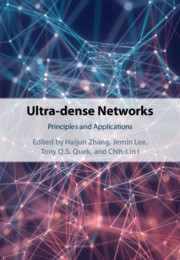Book contents
- Frontmatter
- Contents
- List of Contributors
- Part I Overview
- Part II Physical Layer Design
- 3 NOMA-Based Ultra-dense Networks
- 4 Physical Layer Security in Ultra-dense Networks
- 5 Millimeter-Wave Multiantenna Ultra-dense Networks
- 6 Interference Management in Ultra-dense Networks
- 7 3D-Based Base Station Deployment in Ultra-dense Networks
- 8 Power Control in Full-duplex Ultra-dense Heterogeneous Networks
- Part III Resource Allocation and Network Management
- Part IV Field Trials and Tests
- Index
6 - Interference Management in Ultra-dense Networks
from Part II - Physical Layer Design
Published online by Cambridge University Press: 12 October 2020
- Frontmatter
- Contents
- List of Contributors
- Part I Overview
- Part II Physical Layer Design
- 3 NOMA-Based Ultra-dense Networks
- 4 Physical Layer Security in Ultra-dense Networks
- 5 Millimeter-Wave Multiantenna Ultra-dense Networks
- 6 Interference Management in Ultra-dense Networks
- 7 3D-Based Base Station Deployment in Ultra-dense Networks
- 8 Power Control in Full-duplex Ultra-dense Heterogeneous Networks
- Part III Resource Allocation and Network Management
- Part IV Field Trials and Tests
- Index
Summary
Network densification has become a major contributor to expanding network capacity for the 5th generation and beyond wireless networks. Despite the potential benefits, however, the network over-densification would as well result in unhandlable interference, which is primarily due to the over-use of spectral resources. Therefore, whether the available interference management (IM) techniques are still capable of effectively handling the interference in ultra-dense networks (UDN) becomes doubtful. In this chapter, we first study the new features of the interference in UDN. Then, we make a brief overview of the IM techniques. Performance evaluation is further made, which indicates typical IM techniques fail to effectively mitigate interference in UDN. Considering the new features of the interference, we then discuss how to implement effectively interference management through designing an IM entity for UDN. With the aid of the IM entity, we tailor an effectively IM approach, which is capable of mitigating the severe interference and decorrelating the temporal interference correlation. Results show that the proposed could greatly enhancing network capacity in UDN.
- Type
- Chapter
- Information
- Ultra-dense NetworksPrinciples and Applications, pp. 84 - 106Publisher: Cambridge University PressPrint publication year: 2020

